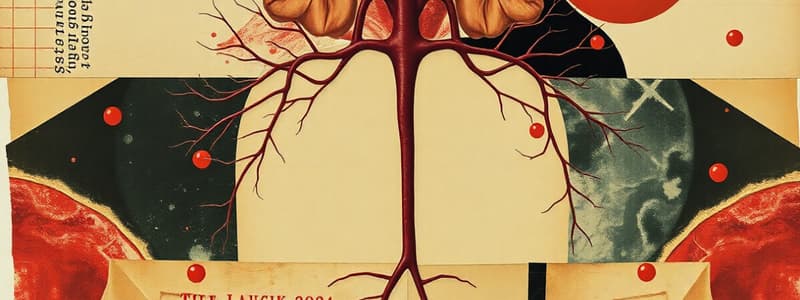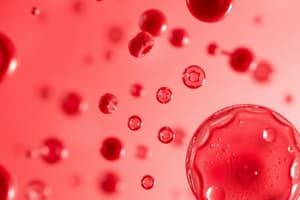Podcast
Questions and Answers
Platelets make up approximately 60% of the total protein composition in blood plasma.
Platelets make up approximately 60% of the total protein composition in blood plasma.
False (B)
Red blood cells are the least abundant type of blood cell in the human body.
Red blood cells are the least abundant type of blood cell in the human body.
False (B)
Blood is considered a type of connective tissue.
Blood is considered a type of connective tissue.
True (A)
The main function of blood is solely transportation of nutrients.
The main function of blood is solely transportation of nutrients.
Plasma comprises approximately 90% water.
Plasma comprises approximately 90% water.
Erythrocytes are biconvex in shape and contain a nucleus.
Erythrocytes are biconvex in shape and contain a nucleus.
Blood vessels include arteries, veins, and capillaries.
Blood vessels include arteries, veins, and capillaries.
Blood helps in regulating body temperature.
Blood helps in regulating body temperature.
White blood cells are the primary components responsible for oxygen transport in the blood.
White blood cells are the primary components responsible for oxygen transport in the blood.
Blood is directly involved in the process of coagulation and defense against pathogens.
Blood is directly involved in the process of coagulation and defense against pathogens.
The majority of carbon dioxide is transported in the blood as HCO3-.
The majority of carbon dioxide is transported in the blood as HCO3-.
The destruction of red blood cells primarily occurs in the liver.
The destruction of red blood cells primarily occurs in the liver.
Men have a higher normal count of red blood cells compared to women.
Men have a higher normal count of red blood cells compared to women.
Erythropoietin is released from the lungs in response to low oxygen levels.
Erythropoietin is released from the lungs in response to low oxygen levels.
Anaemia is characterized by an excess of red blood cells in the bloodstream.
Anaemia is characterized by an excess of red blood cells in the bloodstream.
Iron is essential for the synthesis of hemoglobin in red blood cells.
Iron is essential for the synthesis of hemoglobin in red blood cells.
Neutrophils constitute the least common type of white blood cells.
Neutrophils constitute the least common type of white blood cells.
Phagocytic white blood cells are responsible for clearing debris from destroyed cells.
Phagocytic white blood cells are responsible for clearing debris from destroyed cells.
Eosinophils are primarily involved in combating bacterial infections.
Eosinophils are primarily involved in combating bacterial infections.
High elevations naturally lead to polycythemia due to increased erythrocyte production.
High elevations naturally lead to polycythemia due to increased erythrocyte production.
Flashcards are hidden until you start studying
Study Notes
Circulatory System
- The circulatory system is a transport system that contributes to the body's defenses, coagulation process, and temperature control.
- It is made up of blood, blood vessels, and the heart.
Blood
- Blood is a type of connective tissue that consists of cells, chemicals, and fluid.
- Its function is to transport substances through the body and maintain a stable internal environment.
- Blood's formed elements include red blood cells, white blood cells, and platelets, while the rest is plasma.
Blood Plasma
- It is a straw-colored, sticky liquid portion of blood.
- About 90% of plasma is water.
- Plasma contains:
- Ions: Sodium and Chloride
- Nutrients: Sugars, amino acids, lipids, cholesterol, vitamins, and trace elements
- Three main proteins: Albumin (60%), globulin (35%), and fibrinogen (4%)
- Dissolved Gases: Oxygen and Carbon Dioxide
- Waste Products: Protein wastes such as urea and bilirubin
Red Blood Cells (RBCs)
-
The most abundant blood cells (99%).
-
Structure:
- Biconcave, lacking a nucleus, 8 µm in diameter
- Contains:
- Hemoglobin
- Lipids, ATP, Carbonic Anhydrase
-
Function:
- Transport of oxygen and carbon dioxide – majority of CO2 is transported as bicarbonate (HCO3-)
- pH homeostasis – Carbonic anhydrase facilitates CO2 conversion to HCO3- and H+
-
RBCs bend to pass through small capillaries
-
Destroyed primarily in the spleen.
-
Phagocytic white blood cells remove the debris.
Hematocrit
- The percentage of red blood cells in the blood.
- Typical values:
- Men: 5 million cells/mm3
- Women: 4.5 million cells/mm3
Regulation of Red Blood Cells
- The total number of red blood cells is regulated by a negative feedback mechanism involving erythropoietin.
- The kidneys and liver release erythropoietin in response to low oxygen levels.
Dietary Factors Affecting Red Blood Cell Production
- Vitamin B12 and folic acid are needed for DNA synthesis, crucial for cell reproduction, especially in hematopoietic tissue.
- Iron is necessary for hemoglobin synthesis.
Red Blood Cell Diseases
- Anemia: A reduction in hemoglobin or red blood cell concentration in the blood.
- Polycythemia: An excess of erythrocytes, usually caused by cancer, tissue hypoxia, or dehydration but can occur naturally at high elevations.
Studying That Suits You
Use AI to generate personalized quizzes and flashcards to suit your learning preferences.




